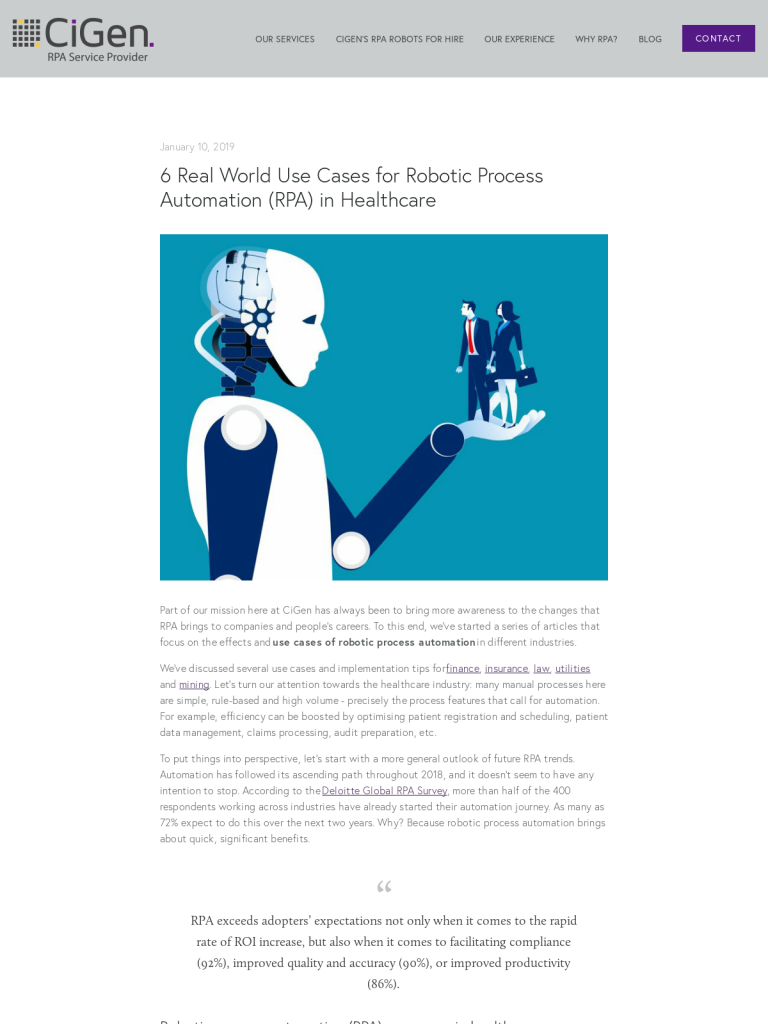6 Real World Use Cases for Robotic Process Automation (RPA) in Healthcare
Original post from https://www.cigen.com.au/cigenblog/

Part of our mission here at CiGen has always been to bring more awareness to the changes that RPA brings to companies and people’s careers. To this end, we’ve started a series of articles that focus on the effects and use cases of robotic process automation in different industries.
We’ve discussed several use cases and implementation tips for finance, insurance, law, utilities and mining. Let’s turn our attention towards the healthcare industry: many manual processes here are simple, rule-based and high volume – precisely the process features that call for automation. For example, efficiency can be boosted by optimising patient registration and scheduling, patient data management, claims processing, audit preparation, etc.
To put things into perspective, let’s start with a more general outlook of future RPA trends. Automation has followed its ascending path throughout 2018, and it doesn’t seem to have any intention to stop. According to the Deloitte Global RPA Survey, more than half of the 400 respondents working across industries have already started their automation journey. As many as 72% expect to do this over the next two years. Why? Because robotic process automation brings about quick, significant benefits.
“RPA exceeds adopters’ expectations not only when it comes to the rapid rate of ROI increase, but also when it comes to facilitating compliance (92%), improved quality and accuracy (90%), or improved productivity (86%).”
Robotic process automation (RPA) use cases in healthcare
RPA use cases in healthcare offer valuable insight into why it’s worth passing on some repetitive tasks, like entering patients’ blood test results into specific files and then consistently updating those files, to software robots. In fact, by knowing which tasks are better handled by bots, the ‘why’ is implicitly answered. Automated processes are faster, more streamlined, and less marred by errors, so customers – the patients, are the first to benefit. Consequently, the clinic itself and its employees will notice the gains and, quite likely, be more determined to continue the automation journey.
1. Hit the high spots of patients’ scheduling
Software robots can streamline online scheduling. Factors received via the appointment request, like diagnosis, location, insurance carrier, personal preferences, etc., can be gathered in a report, and forwarded to a referral management representative who actually makes the appointment.
Who will benefit? Simply put, everybody: an easier job for the call centre personnel, less mistakes, more satisfied customers, and more evenly distributed appointments across doctors’ working time.
2. More effective management of supply processes (claims and billing)
Claims management takes up a lot of healthcare administrators’ time, if only because of the many sub-processes that must be handled: inputting, processing, evaluating, dealing with appeals. Automation can lead to substantially faster and error-free processing, thereby laying down administrators of appreciable burden.
Moreover, consider that a significant amount of healthcare claims (as much as 30-40%, according to a KPMG study) don’t comply with official demands. Software bots can easily identify those exceptions, and thus save many unnecessary payments. By performing more accurate data entry, bots also improve billing efficiency.
3. Improve revenue cycle functions (new patient appointment requests, patient pre-arrival and arrival, claim denials, billing)
Revenue cycles often involve many code changes which can be burdensome for the system. Robotic process automation (RPA) is the right measure to ensure seamless adaptation to these modifications, and therefore an overall coherence. These administrative processes get a boost from data digitisation and from the automation of repetitive tasks like accounts payable.
Thank you. We will be in touch shortly.
4. Support large scale implementation of health plans
By improving patient records management (due to technology features such as high accuracy and minimisation of human error), RPA in healthcare results in tracking more standardised, patient-specific routes towards patients’ desired health objectives.
Automated processes allow more timely identification of patients who deviate from the plans, and consequently, they make it easier to bring them back on track. In fact, continuous remote monitoring of individual records at the level of population health without robotic process automation involves very large costs. According to Peter B. Nichol, “Health plans and providers are discovering software agents as a cost-effective alternative to enhancing or replacing platforms”.
5. Improvement of the care cycle
This is another positive upshot of the above-mentioned continuous record monitoring made possible by improved data analytics with RPA. Analysing comprehensive amounts of data increases the likelihood of more accurate diagnosis, which leads to well-tailored treatment strategies.
Additionally, doctors who don’t have to manually track potentially very large amounts of data because the bots can do it, can invest more time in attending to, and providing human assistance to their patients. This is yet another illustration of a paradoxically humanist outcome of RPA deployment – the fact that technology makes people really matter.
6. Optimised regulatory compliance
Robotic process automation (RPA) ensures that all process steps are tracked, traceable, and documented, as well as systematically organised in well-structured logs. This facilitates the healthcare company’s quasi-permanent readiness to deal with external audits, even unexpected ones.
Conclusion
With the prognosis of a demographic earthquake not too far in the future, the population is not only older, but also in need of medical assistance. As we discussed here, the question “Who will care for them?” should be addressed promptly. The healthcare industry is certainly the one riveted by most eyes, awaiting for (at least) a direction of an answer.
In these conditions, robotic process automation use cases in healthcare offer a swift solution. Software robots can provided a much needed helping hand to the industry facing new demands as times are changing. Adequate care for a growing number of people turns RPA in healthcare into something more than a mere alternative.
If you found the information in this article useful, please subscribe to the newsletter to make sure that you stay updated with news about the fast-evolving automation industry and services.
Leave a Comment
You must be logged in to post a comment.








